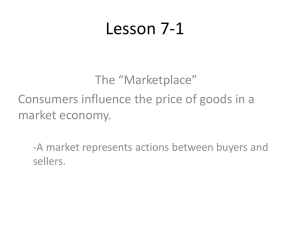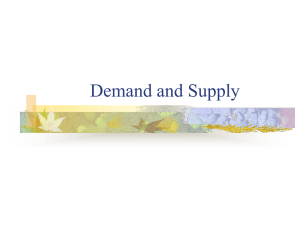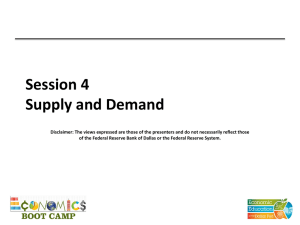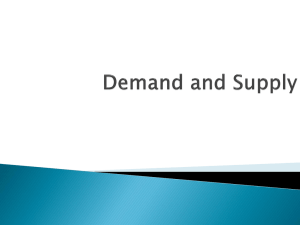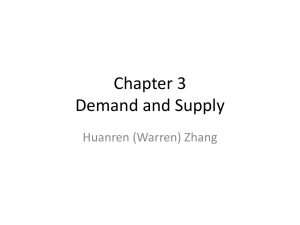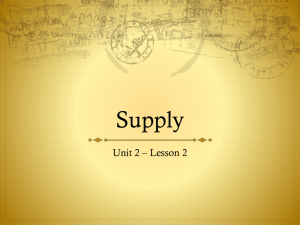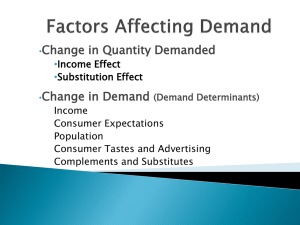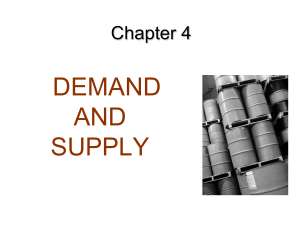Markets: Supply and Demand
advertisement
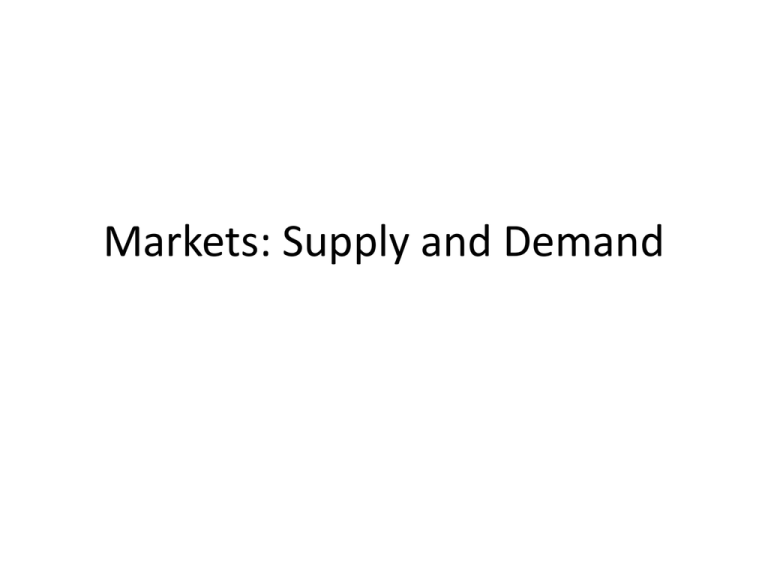
Markets: Supply and Demand Markets • Market : A group of buyers and sellers of a certain good or service • Competitive Market : Many buyers and many sellers so each has small if any impact on the price • Role of Price: information -“price signal” • Perfectly Competitive Market: many buyers and sellers – none have any influence over the market price • Everybody is a price taker • Monopoly : only one seller, so sets the price • Monopsony : only one buyer, so sets the price • Other markets: somewhere between these extremes Demand • Quantity demanded – Amount of a good buyers are willing and able to purchase at a certain price • Law of demand – Other things equal (ceteris paribus) when the price of the good rises the quantity demanded of a good falls • Demand Schedule/Curve : one a table, the other a graph – Both represent the relationship between price and quantity demanded • Individual Demand : Demand of a single individual • We will focus on linear demand curves: – A simplifying assumption Sara’s Demand Schedule and Demand Curve Price Price of Coffee Quantity Demanded (cups) $0.00 6 $0.50 5 $1.00 4 $1.50 3 $2.00 2 $2.50 1 $3.00 0 $3.00 $2.00 $1.00 1 2 3 4 5 Quantity Note: we say price affects quantity – Q=f(P) but price is on “y” axis – comes from historical perspective and fish markets – Marshal? 6 • Market Demand : Sum of all individuals’ demand in that market • Market Demand Curve : Sum up individual demand curves horizontally Market Demand Schedule Price of Coffee Sara David Market $0.00 6 12 18 $0.50 5 10 15 $1.00 4 8 12 $1.50 3 6 9 $2.00 2 4 6 $2.50 1 2 3 $3.00 0 0 0 Market Demand Curve Creation Price Sara’s Demand Price $3.00 David’s Demand $3.00 Price $3.00 $2.00 $2.00 $2.00 $1.00 $1.00 $1.00 4 6 Market Demand 8 12 12 18 More on Demand Curves • Shifts in Demand – Increased Demand • Anything that increases the quantity demanded at all prices • Curve shifts to the right – Decreased Demand • Anything that decreases the quantity demanded at all prices • Curve shifts to the left • Note: Difference between change in quantity demanded and shift in demand P Change in Demand vs Change in Quantity Demanded Increased Demand Change in Demand Change in quantity demanded Decreased Demand Q • What things shift demand (change demand) – Income – Price of related goods – Tastes – Expectations – Number of buyers On Effect of Income • Normal Good: – When income goes up demand goes up – When income goes down demand goes down • Inferior Good: – When income goes up demand goes down – When income goes down demand goes up On Effect of Related Goods • Substitutes (need 2 goods): – An increase in the price of one leads to an increase in demand for the other – A decrease in the price of one leads to an decrease in demand for the other • Compliments (need 2 goods): – An increase in the price of one leads to an decrease in demand for the other – A decrease in the price of one leads to an increase in demand for the other • Tastes: Like it more, increase demand • Expectations: What you think might happen in the future (income, price changes) can affect current demand • Number of buyers: more buyers, increase demand Remember The Difference • Change in price – Change in quantity demanded (movement along demand curve) • Change in all others (income, tastes, price of other goods, etc.) – Change in demand (shift in demand curve) Example Reducing Soda Consumption • Tax sugar – will increase the price – Leads to a movement along the demand curve • Education On Healthy Diet – will change tastes – Lead to a shift in the demand curve P Shift in demand due to change in tastes P’’ Movement along demand due to change in price Tax P’ Q’’’ Q’’ Q’ Q Supply • Quantity Supplied: – Amount of the good that suppliers are willing and able to supply at a specific price • Law of Supply: – All other things being equal, if price goes up quantity supplied will go up • Supply Schedule/Curve : one a table, the other a graph – Both represent the relationship between price and quantity supplied • Individual Supply : Supply of a single individual/firm (seller) • We will focus on linear supply curves: – A simplifying assumption Starbuck’s Supply Schedule and Supply Curve Price Price of Coffee Quantity Supplied (cups) $0.00 0 $0.50 1 $1.00 2 $1.50 3 $2.00 4 $2.50 5 $3.00 6 $3.00 $2.00 $1.00 1 2 3 Quantity 4 5 6 • Market Supply : Sum of all suppliers individual supply in that market • Market Supply Curve : Sum up individual supply curves horizontally Market Supply Schedule Price of Coffee Starbucks Seattle’s Best Market $0.00 0 0 0 $0.50 1 2 3 $1.00 2 4 6 $1.50 3 6 9 $2.00 4 8 12 $2.50 5 10 15 $3.00 6 12 18 Market Supply Curve Creation (sort of) Price Starbuck’s Supply Seattle’s Supply Price $3.00 $3.00 Price $3.00 $2.00 $2.00 $2.00 $1.00 $1.00 $1.00 2 6 Market Supply 4 12 6 18 More on Supply Curves • Shifts in Supply – Increased Supply • Anything that increases the quantity supplied at all prices • Curve shifts to the right – Decreased Supply • Anything that decreases the quantity supplied at all prices • Curve shifts to the left • Note: Difference between change in quantity supplied and change in supply P Change in Supply vs Change in Quantity Supplied Increased Supply Change in quantity supplied Decreased Supply Change in Supply Q • What things shift supply curve (change supply) – Price of inputs: input prices go up, supply goes down – Technology: better tech., increase in supply – Expectations: beliefs about future can affect current supply – Number of sellers: more sellers increases supply • Again remember difference between change in supply (shift of curve) and change in quantity supplied (movement on curve) Equilibrium • Market equilibrium: when markets “clear”, quantity demanded = quantity supplied • Equilibrium price: the price at which the market clears • Equilibrium quantity: the amount of the good bought/sold at the equilibrium Equilibrium Between Demand and Supply P Market Demand Market Supply Equilibrium Price Equilibrium $1.50 Equilibrium Quantity 9 Q Out of Equilibrium • Surplus: excess supply – Quantity supplied > quantity demanded – Downward pressure on price to clear market • Shortage: excess demand – Quantity demanded > quantity supplied – Upward pressure on price to clear market • Note difference between shortage and scarcity Shortage and Surplus Excess Supply Excess Demand P Demand Surplus Supply Supply Price higher than eq. price Price lower than eq. price Demand Shortage Quantity Demanded Quantity Supplied Q Quantity Supplied Quantity Demanded Changes to Equilibrium • Analyzing Changes in the market after some “shock” or change • 1st is supply changed, is demand changed • How is it changed • Graphically make the change and determine new equilibrium • Beware of drawing conclusion based on scale Example: Study finds eating ice-cream increases students GPA What happens? – Demand increases, quantity supplied increases Demand Increases P’’ P’ New Eq. Quantity Supplied Increases Original Eq. Q’ Q’’ Price increased in mkt Quantity increased in mkt Example: Study finds eating ice-cream increases students GPA and price of sugar goes up What happens? – Demand increases, Supply Decreases Demand Increases New Eq. Supply Decreases P’’ P’ Price increased in mkt Quantity increased in mkt Original Eq. But: b/c of scale Q’ Q’’ Example: Study finds eating ice-cream increases students GPA and price of sugar goes up What happens? – Demand increases, Supply Decreases P’’ New Eq. Supply Decreases Demand Increases P’ Original Eq. Price increased in mkt Quantity decreased in mkt But: b/c of scale Q’’ Q’ • So in analyzing market changes be careful of possible ambiguous answers • If supply and demand both change do their changes have the same qualitative effect on price/quantity • If the same then effect is known • If different the effect depends on which is larger
